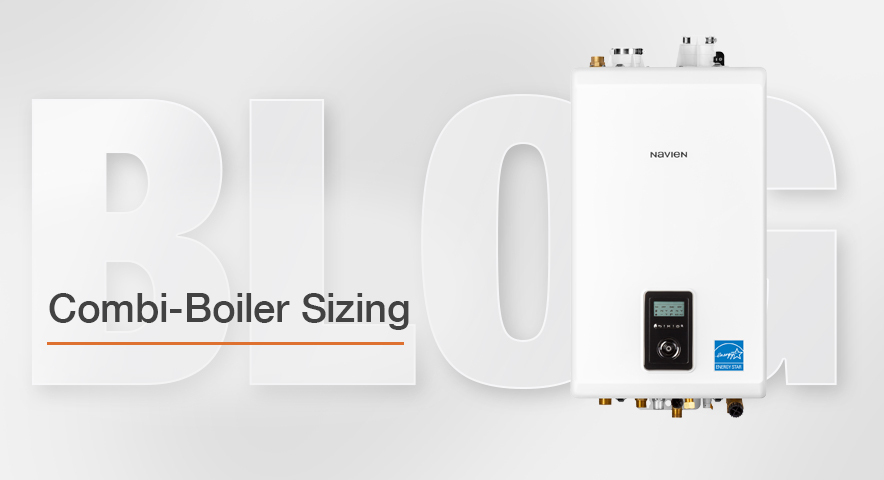In order to properly size a combi-boiler for a home or business, you need to consider both heating and hot water demand, since a combi-boiler supplies both.
With seven models across two series for both residential and commercial use, Navien has the right size combi-boiler for your application—and this article will help you find it!
We also offer a tankless water heater size guide and calculator.
How Combi-Boiler Size Is Measured
Combi-boiler “size” (heating output) is measured using BTU/h (British thermal units per hour). BTU/h represents the heat energy a combi-boiler can generate. A British thermal unit is how much heat it takes to raise the temperature of a pound of water by one degree Fahrenheit. So the more heating and hot water you need, the higher BTU/h your combi-boiler will need.
How to size a combi-boiler
To size a combi-boiler, take into account the size of your home, your space heating needs, and hot water usage, as well as the weather and groundwater temperatures in your region. For an accurate calculation you’ll need to consult a combi-boiler professional, but the following factors can give you an sense of what size will work best for your home.
Heating Considerations
Consider the following factors that affect the required heating output for a combi-boiler:
- Regional climate
- Building insulation value
- Doors and windows (quantity & sizes)
- Skylights
- Number of radiators
- Desired indoor temperature
The best way to find out the required heat load for your home or business is to have an HVAC professional do an assessment. They’ll run the numbers using various measurements including gas meter readings in cold months, R-values (wall, ceiling & floor insulation ratings), U-values (window heat loss), radiator output specs and more to calculate the maximum heat load, which will determine what size combi-boiler you need.
Hot Water Considerations
Consider the following factors that affect the required DHW (domestic hot water) output of a combi-boiler:
- Incoming groundwater temperature
- Number & flow rate of hot water fixtures (taps, showers, dishwashers, etc)
- Number of people in household
The groundwater temperature in your region determines the temperature rise required: how much energy it will take to raise the inlet temperature to the desired temperature. The flow rate of fixtures is measured in GPM (gallons per minute) and should be calculated based on how many fixtures will be used at the same time.
A gas plumber or HVAC company that works with combi-boilers can evaluate your DWH needs, factor in heating demand, and recommend the right size combi-boiler.
Pipe Sizing
Pipe sizing can also affect what size combi-boiler you need, since your home heating and hot water system will need to be compatible with the gauge of hydronic heating pipes and hot water pipes you have in your home.
Small-gauge piping carries less water at a higher pressure, while larger-gauge piping carries more water at lower pressure. If there’s too much pressure in the system it can cause unnecessary wear and tear on radiator valves as well as the boiler part of your combi-boiler.
When a professional evaluates your home’s required heat load they’ll factor in pipe sizing to make sure it meets the pressure requirements of a high-performance heating and DWH system like a Navien combi-boiler.
Should I oversize my combi-boiler?
No, for two reasons: first, because it’s a waste of fuel and energy. Second, because if you oversize your combi-boiler it will cycle (keep running and shutting off repeatedly) instead of running continuously.
Navien combi-boilers are designed to modulate, meaning they adjust the amount of heat produced to match the amount of heat needed. Running consistently and continuously provides the highest level of efficiency and energy savings.
The exception to this is if you plan to add additional heating zones in the future. Always let your contractor know your immediate and long-term plans for your heating system so they can determine which Navien combi-boiler best fits your needs.
What’s the average size of a combi-boiler?
There’s no single average size for a combi-boiler, because the best size for each project depends on not only the size, layout and number of hot water fixtures in your home, but also usage rates.
Between our NCB-H Series and our NFC-H Series, Navien offers seven different sizes of combi-boiler, with heating output ranging from 60,000 BTU/h to 199,900 BTU/h and domestic hot water output from 160,000 BTU/h to 210,000 BTU/h.
Can a house be too large for a combi-boiler?
Some homeowners wonder if a combi-boiler is up to the task of supplying enough heat and hot water for a larger home, such as a 4-bedroom house or even bigger. The Navien NFC-H Series combi-boiler with fire tube technology has enough capacity for today’s larger progressive homes, with heating up to 199,900 BTU/h and hot water up to 210,000 BTU/h, which satisfies all the space heating and domestic hot water requirements of most typical large homes. Plus, one NFC-H combi-boiler can be cascaded and common vented with up to seven NPE tankless water heaters to fill even greater hot water needs.
How many showers can run off of one combi-boiler?
Our largest combi-boiler, the Navien NFC-250/200H, can run up to 3 showers and a dishwasher all at the same time (with 5.4 GPM and a 70°F temperature rise).
Discover Navien combi-boilers
Explore Navien’s NCB-H Series combi-boilers (residential only) and NFC-H Series combi-boilers (commercial or residential) to learn more about your options, or find a combi-boiler installer to get a quote for your project.
